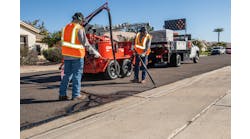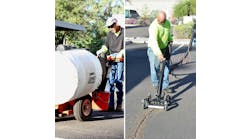Late winters in 2013 and 2014 has Morrison County in central Minnesota, keeping up with maintenance of their 728 miles of roads. “Our goal is to preserve and extend the life of the roadways,” explains John Schelonka, maintenance superintendent for the county. He says they work towards a 20-year life for their mostly two-lane roads. Crack sealing has been the preferred method of pavement preservation when the road surface is approximately two-years-old.
“After the initial crack sealing, we expect to repeat the process eight to ten years later.” Schelonka says. During recent work on Co Rd 46 east of Little Falls, Minn., a contracted crew was working on a 12-mile stretch of aging roadway that was receiving its second round of crack sealing.
“I’m a believer in routing prior to sealing so our specification calls for ¾ in. widening of the crack and ¾ in. depth to provide a good reservoir for the sealant,” says Schelonka—a 23-year veteran of the public works department. Morrison County contracts with All Things Asphalt, Sauk Center, Minn., for several types of pavement preservation including crack sealing.
The equipment on the Co Rd 46 project included two PCR 30 routers and two Magma crack sealers, all manufactured by the Cimline Pavement Maintenance Group located in Plymouth, Minn. A truck-mounted air compressor and tow vehicles were also part of the equipment mix. The sequence of operation was two routers widening and deepening the cracks, followed by one man blowing out the debris in the cracks with compressed air. The two Magmas with 230 gal capacity each, followed. Both units are towed by trucks carrying the 30 lb blocks of sealant that are continuously loaded into the melters and heated to 350-400° for optimum flow and adhesion.
Crack sealer operators have a range of motion thanks to a boom-mounted hose and ergonomic wand. The first crack sealer fills the void three-quarters full and the second operator tops off the void and applies an over band approximately 4 in. wide. The Cimline melters recirculate the hot sealant when there is a break in the process to keep the temperature even for consistent sealing. Crews worked on one lane in each direction and the process was expected to take five days for 12 miles. Flaggers keep the rural traffic off the fresh sealant to prevent tracking.
“We like to start crack sealing in February when the crack is often at it’s widest, “ Schelonka notes, “By mid-May the cracks are starting to close-up.” By attacking the crack in later winter, the freeze-thaw of water contamination that occurs in spring can be avoided. It is this expansion and contraction of the pavement that deteriorates pavement resulting in cracks that if left unattended, can result in potholes and broken pavement.
“We have allocated some budget for contracting the crack sealing to keep up with our pavement maintenance to prevent the premature failure of the roads,” says Schelonka.



